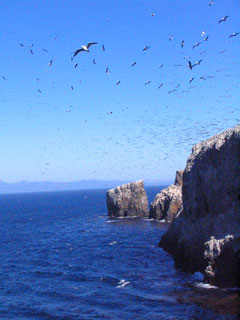ABSTRACTIn this simulation, students work in groups to design a marine reserve in a hypothetical island state called “Udubia.” After learning about marine reserve design, students will choose characters that represent a variety of stakeholders, be placed in like-minded groups, create a reserve design based on provided data sources, and defend it in a presentation and debate. An optional individual assignment allows them to develop and defend their positions separately by writing a letter to the “governor.” At least two weeks will be needed to complete this exercise, including 1-3 class periods, although it can be modified for shorter use. AUTHORSBonnie J. Becker1 and Peter A. Selkin2 1 - Interdisciplinary Arts and Sciences, University of Washington Tacoma, Tacoma, WA 98402; bjbecker@u.washington.edu 2 - Peter A. Selkin CLASS TIME
OUTSIDE OF CLASS TIMEIt is suggested that at least two weeks are provided between submission of characters and the debate to allow for adequate preparation time. However, this exercise has been modified to be completed within one class period with no outside work. Total outside class time:
STUDENT PRODUCTS
SETTINGThis simulation can be done in class, with no need for laboratory equipment or field work. COURSE CONTEXTThis simulation was designed for a lower division Conservation Biology lecture course (majors and non-majors combined) with approximately 40 students, and has also been used (in modified form) in an Oceanography lecture course and an Introductory Biology class with approximately 40 and 60 students respectively. The activity could be used in an introductory environmental studies/science course or an ecology or marine ecology course with an applied focus. INSTITUTIONThe simulation was designed with a small, public, 4-year undergraduate university in mind, but was also used in a condensed format at a community college. TRANSFERABILITYThe activity is easily transferable to a variety of student audiences, including majors and non-majors, in lower division and pre-college environments. It is best to use in a larger (greater than 20 student) class and would need further modification for use in upper division courses. A disabled student (sight-impaired) has participated in the simulation with little need for special accommodation, and it is anticipated that few issues will affect students with other disabilities. Suggestions for modifying the existing exercise into a more abridged format are given below. ACKNOWLEDGMENTSThis simulation was created by the authors at the University of Washington Tacoma. We would like to thank Dr. Tonya Huff for her feedback on her use of the exercise in her classes, Dr. Rachel May for the framework of creating a debate assignment and confidential peer assessment, Dr. Anne Beaufort for her inspiration on the paper rubric, and the students of TESC 232 for serving as a model class. CITATIONBonnie J. Becker and Peter A. Selkin. February 23 2009, posting date. Marine Reserve Design: Simulating Stakeholder Options. Teaching Issues and Experiments in Ecology, Vol. 6: Experiment #3 [online]. http://tiee.ecoed.net/vol/v6/experiments/marine_reserve/abstract.html
|

The small marine reserve on Anacapa Island, Channel Islands National Park, has been closed to fishing since 1978.
Copyright: Image by author (Bonnie J. Becker), used by TIEE with permission. full size image |
|
<top>
|
|